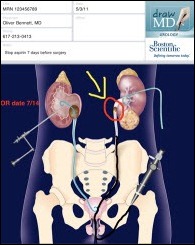News 5/10/11
Emdeon first quarter results: revenue of $271.5 million, up 14.4% year-on-year; operating income of $23.7 million, off 23% from last year due to higher expenses. Net income grew 70% to $7.3 million and net income per diluted share was $0.05 compared to last year’s $0.02. Adjusted net income came in at $0.23/share, which is about a penny off analysts’ expectations.
Culbert Healthcare Solutions hires Jeff Wasserman to lead the company’s Strategy and Executive Services team. He was previously with The Bard Group, Stroudwater Associates and with the University of Wisconsin Hospital and Clinics.
athenahealth awards Atul Gawande, MD its first annual athenahealth Vision Award in recognition of “making healthcare work as it should.” Gawande is a staff writer for the New Yorker and on the surgical staff of Brigham and Women’s Hospitals and the Dana Farber Cancer Institute.
Johnson Dermatology (AR) opens a LEED-eligible clinic that includes a water tower for rainwater collection, geothermal heating and cooling, and building materials made primarily of pre- or post-consumer recycled content. The husband and wife physicians also use EHR in order to save some trees.
Online physician directory Avvo says that ophthalmologists and other eye care professionals use social media and online marketing more than any other physician segment. Seems to me that ophthalmologists have always been ahead of the curve in terms of self-promotion. Early in my career, the lead physician for a large ophthalmology group asked for my opinion of the use of a billboard to promote the practice. I told him I hated the idea because I felt billboards were unseemly for a medical professional. He ignored me. Last I heard, he retired rich at a young age.
MED3OOO is hosting a Webinar May 11 to show off the integration between its InteGreat EHR with Medicomp’s Quippe technology. I checked out the InteGreat/Quippe product at HIMSS (as did Mr. H, Dr. Gregg, and Dr. Jayne) and was mighty impressed.
Practice Fusion introduces an EMR calculator that allows providers to predict how much they can save using Practice Fusion compared to three of the top EMR vendors. The company claims it has saved providers over $57 million to date, based on an estimate that EMR for a five-physician primary care practice is $50,000 for the first year, including implementation and operation costs. I am looking forward to comments from both the naysayers and the Practice Fusion faithful.
And in other free EHR news, Mitochon Systems announces that it is the first free EHR vendor to earn complete ONC-ATCB certification.
Doctors can make stroke diagnoses using an iPhone application with the same accuracy as using a medical computer station, according to research from the University of Calgary’s Faculty of Medicine. Using Calgary Scientific Inc.’s ResolutionMD Mobile application, neuro-radiologists diagnosed acute stroke by analyzing brain and head scans images. Researchers say that physicians using the iPhone app make correct diagnoses 94 to 100% of the time.
Meanwhile, a German study finds that a computer-based acromegaly detection program is more accurate than human experts. The computer program analyzed photos of individual faces and was correct 70% of the time; human experts identified the condition correctly just 60% of the time.
Allscripts makes a strategic investment in clinical analytics company Humedica. The companies will collaborate to market Allscripts Clinical Analytics Powered by Humedica, a new module which Allscripts will integrate with both its acute and ambulatory EHRs.
drawMD launches an iPad application developed by urologic surgeons. The The drawMD Urology iPad application allows physicians to use interactive imagery to illustrate and describe treatment options for medical conditions.
NaviNet names S. Michael Ross chief medical officer and David Kates VP of product management and clinical strategy. Both joined the company from Prematics, which NaviNet acquired last year.
Pediatric Alliance (PA) selects Ascent Data to provide data management services and support.
Physicians express concern with inaccuracies on Medicare’s Physician Compare Website, which by 2013 will also include physician quality performance details. Common problems include name misspellings, locality mistakes, and listings for physicians that are deceased or no longer associated with a practice. Physicians worry that if CMS can’t get biographical information right, then performance scores and other quality data might not be a trustworthy resource for patients.
Southeast Eye (GA) selects NextGen EPM PM and EHR for their eight-location practice. TSI Healthcare will provide implementation services.




















The article about Pediatric Associates in CA has a nugget with a potentially outsized impact: the implication that VFC vaccines…